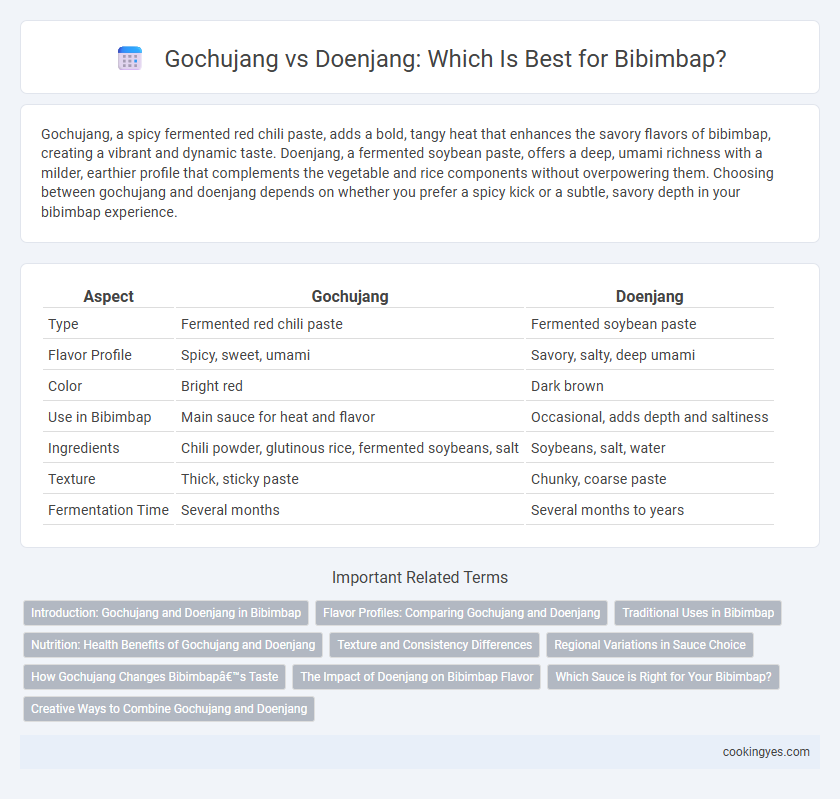Gochujang, a spicy fermented red chili paste, adds a bold, tangy heat that enhances the savory flavors of bibimbap, creating a vibrant and dynamic taste. Doenjang, a fermented soybean paste, offers a deep, umami richness with a milder, earthier profile that complements the vegetable and rice components without overpowering them. Choosing between gochujang and doenjang depends on whether you prefer a spicy kick or a subtle, savory depth in your bibimbap experience.
Table of Comparison
| Aspect | Gochujang | Doenjang |
|---|---|---|
| Type | Fermented red chili paste | Fermented soybean paste |
| Flavor Profile | Spicy, sweet, umami | Savory, salty, deep umami |
| Color | Bright red | Dark brown |
| Use in Bibimbap | Main sauce for heat and flavor | Occasional, adds depth and saltiness |
| Ingredients | Chili powder, glutinous rice, fermented soybeans, salt | Soybeans, salt, water |
| Texture | Thick, sticky paste | Chunky, coarse paste |
| Fermentation Time | Several months | Several months to years |
Introduction: Gochujang and Doenjang in Bibimbap
Gochujang, a spicy fermented red chili paste, brings a bold, sweet, and umami-rich flavor that defines the signature taste of traditional bibimbap. Doenjang, a savory fermented soybean paste, offers a deeper, earthier undertone that enhances the complexity of bibimbap without overpowering the fresh vegetables and rice. Both condiments are essential in Korean cuisine, but gochujang remains the primary sauce for bibimbap due to its balanced heat and subtle sweetness.
Flavor Profiles: Comparing Gochujang and Doenjang
Gochujang provides Bibimbap with a spicy, sweet, and savory kick, characterized by its fermented chili pepper paste base and subtle umami notes. Doenjang contributes a deep, earthy, and salty flavor profile derived from fermented soybean paste, offering a more robust and mellow taste. The choice between Gochujang and Doenjang significantly influences the overall flavor balance, with Gochujang enhancing heat and sweetness, while Doenjang imparts richness and complexity.
Traditional Uses in Bibimbap
Gochujang and Doenjang each bring distinct traditional flavors to Bibimbap, with Gochujang providing a spicy, sweet, and savory profile that enhances the mixed rice and vegetable dish's signature taste. Doenjang offers a rich, deep umami flavor, often used in Bibimbap variations that emphasize fermented soybean pastes for a more earthy and robust character. Traditionally, Gochujang remains the primary condiment in classic Bibimbap recipes, highlighting its role in balancing the dish's diverse ingredients with a bold, vibrant punch.
Nutrition: Health Benefits of Gochujang and Doenjang
Gochujang, a fermented red chili paste, is rich in capsaicin, which boosts metabolism and aids digestion, while also providing antioxidants that support immune health. Doenjang, a fermented soybean paste, offers high levels of probiotics, essential amino acids, and is known for its anti-inflammatory and gut health-promoting properties. Both contribute essential nutrients and beneficial microbes, making them valuable components in a nutritious bibimbap bowl.
Texture and Consistency Differences
Gochujang has a thick, sticky texture with a smooth consistency that coats bibimbap ingredients evenly, providing a sweet and spicy flavor profile. Doenjang features a coarser, grainier texture due to its fermented soybean paste composition, offering a richer umami taste with a slightly chunky consistency. The viscosity of gochujang allows for easy blending, while doenjang's denser paste adds depth and a heartier mouthfeel to bibimbap.
Regional Variations in Sauce Choice
Gochujang, a spicy red chili paste, is predominantly favored in southern Korea for bibimbap, adding a vibrant heat and sweetness that complements the dish's fresh ingredients. Doenjang, a fermented soybean paste with a savory umami depth, is commonly used in the central regions, offering a richer, earthier flavor profile that enhances the overall complexity of bibimbap. Regional preferences reflect cultural tastes and ingredient availability, influencing the traditional sauces that define local bibimbap variations.
How Gochujang Changes Bibimbap’s Taste
Gochujang intensifies Bibimbap's flavor by adding a spicy, sweet, and savory depth that enhances each bite with a balanced heat and umami richness. Unlike Doenjang, which offers a fermented soybean earthiness, Gochujang's chili paste brightens the dish and brings a signature Korean warmth. This fiery seasoning transforms Bibimbap into a vibrant culinary experience by amplifying the harmony between rice, vegetables, and meat.
The Impact of Doenjang on Bibimbap Flavor
Doenjang imparts a deep, savory umami taste to bibimbap, enhancing its earthiness compared to the spicy heat of gochujang. The fermented soybean paste enriches the dish with complex flavors, balancing the freshness of vegetables and richness of rice. This robust, mellow profile transforms bibimbap into a more nuanced and satisfying meal.
Which Sauce is Right for Your Bibimbap?
Gochujang, a spicy fermented red chili paste, adds a bold, sweet-heat flavor essential to traditional Bibimbap, enhancing the dish's vibrant mix of vegetables and rice. Doenjang, a savory fermented soybean paste, offers a deeper umami taste, providing a richer and earthier alternative for those seeking a milder, saltier profile. Choosing between Gochujang and Doenjang depends on whether you prefer Bibimbap with spicy sweetness or a more robust, savory character.
Creative Ways to Combine Gochujang and Doenjang
Combining gochujang and doenjang in bibimbap elevates its flavor profile by blending the spicy, sweet heat of gochujang with the deep, umami-rich earthiness of doenjang. Creative recipes mix a small amount of doenjang into gochujang-based sauce to balance intensity with savory depth, enhancing the harmony of textures and tastes. Experimenting with ratios allows for customization, making each bibimbap uniquely flavorful while highlighting traditional Korean fermented pastes.
Gochujang vs Doenjang for Bibimbap Infographic

 cookingyes.com
cookingyes.com